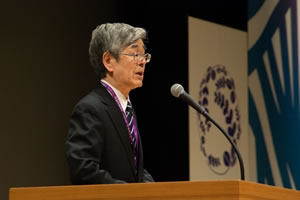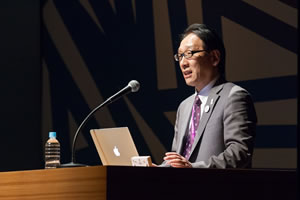Message
The 3rd World Conference on Disaster Risk Reduction
Susumu Satomi
President, Tohoku University

For five days from March 14~18, 2015 more than 180 nations from the United Nations (UN) participated in the 3rd World Conference on Disaster Risk Reduction in Sendai, Miyagi. Approximately 150,000 people took part, making it the biggest conference ever held in Japan.
This conference was held by the UN to draw up a global strategy on disaster prevention. The first conference was held in 1994 in Yokohama, Kanagawa followed by a second conference in 2005 in Kobe, Hyogo where the “Hyogo Framework for Action 2005-2015,” — a global disaster prevention guide that denotes exemplary actions for nations to reduce the risk by 2015 — was developed.
The 3rd conference was held in order to construct a new global framework for disaster prevention. The “Sendai Framework for Disaster Risk Reduction 2015-2030” was successfully created, with policies that aim to reduce the number of casualties and economic damage throughout the world as a result of natural disasters.
For Tohoku University, it was an opportunity to report on activity from the “Institute for Disaster Reconstruction and Regeneration Research” — a multi-disciplinary university institute built following the 2011 Great Eastern Japan Earthquake. As a university situated in the disaster area, we have brought together the expertise of the entire academic community to contribute to disaster management, education, and mitigation, both domestically and globally.
At the Tohoku University Symposium, held at the Tokyo Electron Hall Miyagi, we were honored to have Mr. Ban Ki-moon, the Secretary-General of the United Nations, give a keynote speech praising the 100+ reconstruction projects that we have been working on as a member of UN Academic Impact.
During the symposium, a press conference was held to announce the establishment of the “Global Centre for Disaster Statistics” in the International Research Institute of Disaster Science (IRIDeS), Tohoku University. In cooperation with the UNDP, the role of the Global Centre of Disaster Statistics is to accumulate disaster statistics from countries around the world, analyze the acquired data, and share the results globally to contribute to disaster prevention and development policies.
At the press conference, Ms. Helen Clark, the Administrator of the United Nations Development Programme, commented that “continuous development does not happen without understanding the risk.” She expects the Global Centre of Disaster Statistics will play a crucial role in providing scientific data to predict and therefore prevent risks.
The conference was a huge success, and Tohoku University will continue to contribute to the reconstruction of Tohoku and revitalization of Japan. I would like to thank all participants who were involved in our events and projects, and ask for your continuous support to further strengthen the cooperative base for worldwide disaster research and education.
Tohoku University’s contribution to the 3rd United Nations World Conference on Disaster Risk Reduction
Nobuyoshi Hara
Executive Vice President of Tohoku University for Earthquake Disaster Reconstruction

On March 19, I received an email with the subject line: News Flash – 3rd UN World Conference on Disaster Risk Reduction. The email was from Professor Yuichi Ono, of the International Research Institute of Disaster Science (IRIDeS). Although I had heard the announcement on the morning news, he wrote to me that the “Sendai Framework for Disaster Risk Reduction 2015 – 2030” had been officially adopted just after midnight. In his email, Professor Ono said, “I’d like to share this wonderful news with you, and dedicate it to the approximately 20,000 people who lost their lives.” His message summed up the collective response of relief and triumph for all the hard work we’d put in to succeeding the world conference.
Tohoku University solidly supported Sendai City to host and hold the 3rd United Nations World Conference on Disaster Risk Reduction (UNWCDRR). After Sendai was officially chosen as the host city, the university decided to promote both initiative and liaison contributions for the success of the 3rd UNWCDRR. The initiative contribution was aimed to commit to creating a new framework for replacing the pre-existing “Hyogo Framework for Action” on the basis of the lessons learnt from the 2011 Great East Japan Earthquake, and also to report the activities of our reconstruction projects nationwide. The liaison contribution included various kinds of support as a core member of Sendai Committee for the 3rd UNWCDRR.
The Preparation Office for the 3rd UNWCDRR was established at the university, and under this umbrella, the Response Project Team was charged with planning of the initiative contribution and the Liaison Council was tasked with coordinating communication with Sendai City.
As a result, the following contributions were made:
(1) Tohoku University staff including President Satomi, participated as keynote speakers in four out of ten special public forums hosted by the Government of Japan and the Sendai Committee.
(2) Twenty four university departments assisted in planning 34 symposia, set up 16 exhibition booths and 8 poster displays, and conducted 4 study tours. The university’s projects contributed to more than 10% of projects hosted by domestic organizations. Approximately 4,500 people attended our symposia, while approximately 4,000 people visited our exhibitions.
(3) The university published 3,000 copies in English and Japanese of information on reconstruction projects in the 5th volume of “Tohoku University Reconstruction Action.” These were distributed during the conference.
Websites and pamphlets in English and Japanese were created to share information on events hosted by the university. An introduction to the university’s reconstruction projects was outlined in a video.
(4) Many university facilities, including the Tohoku University Centennial Hall (Hagi Hall) on Kawauchi Campus, opened its doors for use as a conference venue.
(5) Thirty five percent of all volunteer interpreters were from Tohoku University, ninety percent of these being students. More than 50 students volunteered their time to make meaningful contributions in managerial roles.
Of great significance to the 15 year proposal in the “Sendai Framework for Disaster Risk Reduction” is the inclusion of the word “Sendai” in its title. The UN Secretary-General’s Special Representative for Disaster Risk Reduction, Ms. Margareta Wahlström, claims to have used the place-name in the framework title in homage to people in the disaster hit area. We also believe her message contains an expectation for Sendai and Japan to execute the disaster risk reduction principles outlined in the framework. “Sendai” should become a symbolic word succeeding “Hyogo” in the field of disaster risk reduction, as “Fukushima” became a symbol of the tragedy of the 2011 Great East Japan Earthquake and Tsunami. Tohoku University has served as an academic hub for promoting recovery and reconstruction of the disaster-affected region including Fukushima and thus accumulated a vast amount of knowledge in the field of disaster risk reduction and reconstruction. As revealed by the establishment of the Global Centre for Disaster Statistics in IRIDeS, international expectations about Tohoku University’s roles in the field of disaster risk reduction have become heightened after the 3rd UNWCDRR. We believe that our progressive efforts will bring contributions to the international society in the future. We would like to thank you for your continued support.
The Role of Research/Education at the 3rd United Nations World Conference on Disaster Risk Reduction and Planning towards Future Contributions Fumihiko Imamura
Director, Tohoku University International Research Institute of Disaster Science

Tohoku University contributed to the 3rd United Nations World Conference on Disaster Risk Reduction (UNWCDRR) by providing data and expertise on disaster management – through our collective knowledge as a major research base in the Tohoku area. We also provided venues for numerous seminars and symposum.
Much of our background information is based on the experience of having survived the Great East Japan Earthquake in 2011. From the initial phase of recovery, to the reconstruction process, we hope to share our experience and the lessons we learned from the disaster – both domestically and internationally.
Tohoku University decided to support the proposal to hold the 2015 UNWCDRR in Sendai, so that visitors to the region could observe the reconstruction process first hand. University staff visited Geneva, New York and other cities to seek support for the proposal.
We focused on how research/education can influence international policies on disaster risk reduction and prevention. We believe that the introduction of new findings and knowledge through research helps inform policy making and improve strategic planning.
Tohoku University’s International Visitor Research Centre, The Tohoku Forum for Creativity hosted symposiums and workshops on disaster science and international policy where the role of research/education was discussed.
We teamed up with UN organizations, and hosted workshops on disaster statistics and worked to achieve a consensus on the importance of data accumulation and management.
A review of the “Hyogo Framework for Action” was undertaken, and comparisons were made to the situation in Tohoku following the Great East Japan Earthquake. The results of this review were published in a report in both Japanese and English. And subsequently, the report has played a central role in the preparation for the conference, as it has highlighted reconstruction activities in the disaster hit areas. The information was used to help creating the “Sendai Declaration” and the “Sendai Framework for Action,” both cornerstones in the success of the UNWCDRR conference.
The UNWCDRR in Sendai provided a starting point for further investigation into disaster management.
In 2015, Tohoku University will take part in international conferences that aim at creating a consensus on globally important subjects, such as international development and climate changes.
New agendas on development are planned to be adopted in September, 2015 in New York. Following this, a more binding agreement on climate change will be made in December in Paris. The possibility of people around world being affected by disaster is on the increase, and we’re facing further challenges because of this.
The newly adopted “Sendai Framework” provides guidelines for disaster prevention and reduction policies around the world, and will remain in place until 2030.
Tohoku University aims to strengthen the bonds between industry, academia, government and the community; while implementing strategies for disaster mitigation that include the following priorities:
(1) Understand the risk of disaster while implementing risk reduction strategies. Build disaster resilient communities so that economic and overall recovery is swift.
(2) Strengthen areas of disaster response at the local body and government levels.
(3) Reinforce disaster prevention measures.
(4) Encourage the role of education in evaluating what is needed to create disaster resilient communities.
I would like to thank everyone who supported us in making this conference a success, and ask for your continuous support in our future activities.




